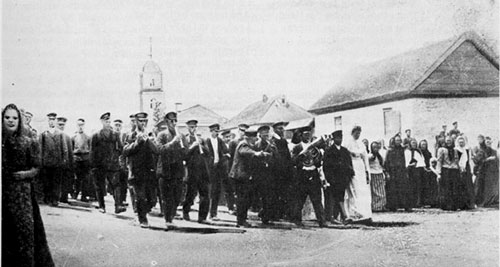The actual marriage service forms the culmination of the wedding celebration. It was customary for the bridegroom, accompanied by two attendants, to call for the bride at her house. The bride, festively attired in a long white dress, bridal wreath and veil, and surrounded by her attendants, wept, sometimes not just for the sake of the ceremony of leaving her parents' home. In many cases, the tears were genuine, particularly if the girl had been forced into marriage. As the bride removed her wreath, a song was sung years ago, whose words heightened the melancholy mood of the girl compelled from now on to live in a strange house.
Another form of German Russian music are the Dusches, or traditional wedding toasting songs. According to Kurt Goldenstein, these songs were played slowly and sung by men. They were meant to be sung with emotion and feeling, so the tempos often changed within the song. Every community had its own Dusches for the bride the brides father, the musicians, etc...
According to Kurt Goldenstein, in his book Colorado Dutch Hop Music, the early wedding and dance bands in Russia usually consisted of a hammered dulcimer, two violins, and a bowed bass violin. One violin would take the lead while the other instruments play harmony and accompaniment. The German-Russians also had bands comprised solely of wind instruments, but they were rarely used for dances. The wind instruments were often used when a bride and groom entered or exited a church or wedding house. This custom was continued in America and was termed "blowing." Hochzeit or wedding dances were held after the ceremony.
Volga German Wedding Music (Kevin Rupp)
